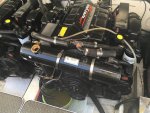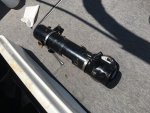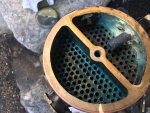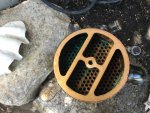- Joined
- Jul 18, 2011
- Messages
- 17,704
I am on the 4th year of my (2) closed cooling systems on my twin Merc 7.4 LX MPI engines. They are the FULL version of closed cooling, so they do the block and the manifolds.
I added them to 16 year old 740 hour 'fresh water only' engines when I bought the boat up over at Lake Winnipesaukee in 2012.
The first 2 years of use were uneventful and both engines ran in the 155-165 F range all day long. so, no worries . . . I also have sea water strainers on the intake lines before the sea water pumps from day 1, so no crud would reach the heat exchangers.
Last year I noticed the port engine started to run a bit higher than it did previously (165-170) and took noticeably longer to 'recover' when going from cruising speed down to wake speed. The starboard engine was A-OK. I cleaned the sea water strainers to see if it made a difference, but it was minor if any.
Fast forward to this year, I filled both heat exchangers to start the season, as they were a few ounces low. The port engine is now running at 175-180, while the starboard engine is still at its original 155-165. Sooo, I think I should do something before it reaches 'the boiling point'.
Engines now have about 880 hours on them, so I have done about 45 hours per year in the first 3 years.
I'm going to take a look at the engines this weekend, but I thought I would put the question out here for some ideas and input.
My thoughts are:
Port heat exchanger is becoming clogged from sediment in the engine block . . .
Maybe the port engine thermostat is getting funky . . .
Some other kind of flow restriction on the closed side of the port engine cooling system.
Maybe even a flow restriction on the 'open' side of the cooling system.
What else should I consider/check ??? :noidea:
Also I am not sure about checking the rate of flow of 1 engine versus the other . . . :noidea:
Thanks in advance for any comments/suggestions. :thumb:
Serial #'s are in my Sig below.
I added them to 16 year old 740 hour 'fresh water only' engines when I bought the boat up over at Lake Winnipesaukee in 2012.
The first 2 years of use were uneventful and both engines ran in the 155-165 F range all day long. so, no worries . . . I also have sea water strainers on the intake lines before the sea water pumps from day 1, so no crud would reach the heat exchangers.
Last year I noticed the port engine started to run a bit higher than it did previously (165-170) and took noticeably longer to 'recover' when going from cruising speed down to wake speed. The starboard engine was A-OK. I cleaned the sea water strainers to see if it made a difference, but it was minor if any.
Fast forward to this year, I filled both heat exchangers to start the season, as they were a few ounces low. The port engine is now running at 175-180, while the starboard engine is still at its original 155-165. Sooo, I think I should do something before it reaches 'the boiling point'.
Engines now have about 880 hours on them, so I have done about 45 hours per year in the first 3 years.
I'm going to take a look at the engines this weekend, but I thought I would put the question out here for some ideas and input.
My thoughts are:
Port heat exchanger is becoming clogged from sediment in the engine block . . .
Maybe the port engine thermostat is getting funky . . .
Some other kind of flow restriction on the closed side of the port engine cooling system.
Maybe even a flow restriction on the 'open' side of the cooling system.
What else should I consider/check ??? :noidea:
Also I am not sure about checking the rate of flow of 1 engine versus the other . . . :noidea:
Thanks in advance for any comments/suggestions. :thumb:
Serial #'s are in my Sig below.
























